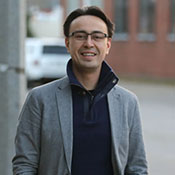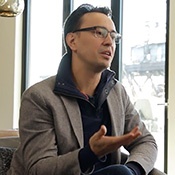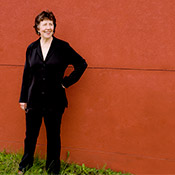
Connecting the Contemporary: Ken-David Masur weaves together old and new
Paul Kosidowski
PUBLISHED
Tagged Under: 2019.20 Season, Classics, Conductor, MSO Notable
Ken-David Masur is a busy man these days. When I catch up with him on a chilly January morning, he’s already dropped his kids off at school, chatted with contractors working on his recently purchased Milwaukee home, and had two symphony-related meetings. He’s dressed for the season, though his stylish parka and boots say “hopping screenings at Sundance” rather than snow blowing a Wisconsin driveway.
Still to come: another meeting at the Marcus Center, and the MSO Friday matinee concert, after which he’ll catch up with the conductor, his friend Stefan Asbury.
But all that to-ing and fro-ing is quickly forgotten when we sit down to have a conversation about contemporary music and its place on MSO programs. It’s obviously something he feels passionate about.
During Masur’s inaugural season as music director, audiences have been introduced to several celebrated contemporary composers: Detlev Glanert, Alfred Schnittke and Grammy-award winner Kaija Saariaho. Masur isn’t interested in merely sprinkling a bit of contemporary work among the standard repertoire. He has strong feelings about these composers, some of which he knows personally, and he wants us to see the connections between the past and “the now.”
“It’s become clear to me that contextualizing so-called contemporary music with the old masters is so very important,” Masur says. “Alfred Schnittke was highly original (he died in 1998), but he had a complete knowledge of what came before. He was like a modern painter who studies the greats. He learns to paint in the style of Rembrandt or DaVinci, but then his style morphs into something completely new.”
The blend of past and present is clear in the titles: Glanert’s “Brahms-Fantasie, Heliogravure for Orchestra,” and Rodion Shchedrin’s “Beethoven’s Heiligestadter Testament,” named for the famous letter the composer wrote in which he despaired about his ensuing deafness.
“Contemporary music should not be isolated,” he explains. “I’ve been trying to get away from the idea of separation”—the idea that contemporary music should be confined to festivals or separate concerts. For him, the path from the 16th century to today is unbroken. And compellingly fascinating.
That conviction reflects Masur’s musical life, which has embraced both masterpieces and the excitement of new works. He grew up in Leipzig, Germany, “surrounded by a community that celebrates wonderful masterpieces.” But he became interested in composing from an early age, attending the Boston Symphony’s Tanglewood Institute as a high schooler. His later training at Columbia University reflects his eclectic and voracious curiosity. At one point, he was involved in four different ensembles—specializing in Bach, musical theater, Asian music, and contemporary music.
“I wanted to bring my Leipzig ‘home feeling’ to the Bach ensemble,” he recalls, “but I also wanted to make sure I got involved with genres and styles that were more unfamiliar.”
That interest in contemporary music continues to this day, but he also understands that an appreciation of contemporary work can be a steep climb for symphony audiences. I ask Masur what would say to people who tell him they didn’t understand a particular contemporary piece.
“I’d tell them, ‘It might be the same for me,’” he says quickly. “The musicians on this stage are not people who are presenting something they have figured out. It’s the opposite. But we go through it together, and when we come out on the other side, we are all different people who have been enriched. I think it’s about asking the audience and musicians to come on a journey of discovery together.”
That interest in connection informs Masur’s approach to programming—picking pieces for individual concerts that are diverse, but also linked in interesting ways. For Masur, appreciating new music is more enriching when you hear connections. “You can’t just isolate it and say, ‘Okay, here’s the new piece.’ The new and the ‘old’ are woven together thematically.”
The MSO’s Pabst Theater concert on February 22 & 23 is a great example. Start with the main attraction, Mendelssohn’s Fourth Symphony, the so-called “Italian” symphony. Well, since we’re “in Italy,” why not add some Renaissance brass music from the Venetian Giovanni Gabrieli? And then circle back to Mendelssohn and feature an overture that reflects his passion for brass, the Trumpet Overture. Add the sunny and youthful Beethoven Piano Concerto No. 2 (with soloist Orion Weiss), and so far, you have a program filled with interesting connections and contrasts.
But what contemporary music would fit in to this musical tapestry? This time, the addition of a contemporary piece involved a bit of a search. “We were looking for something that would create some spark,” Masur recalls. “I came across Michele Dall’Ongaro. He wasn’t a composer I knew or had met before, but his piece, La Primavera, had the same effect on me as Mendelssohn’s music.”
“The energy!” Masur adds. “Read Mendelssohn’s life story, or the letters he exchanged with his sister. What youthfulness! He did gymnastics and seemed to always be jumping up and down! He wrote all that music. And so quickly! Mendelssohn had this spark, and that’s what I heard in Dall’Ongaro’s piece. I heard it, and said ‘This is the spirit of Mendelssohn!’”
You can hear Masur’s tapestry of a program when he conducts the Milwaukee Symphony Orchestra on Feb. 22 and 23 at the Pabst Theater.



